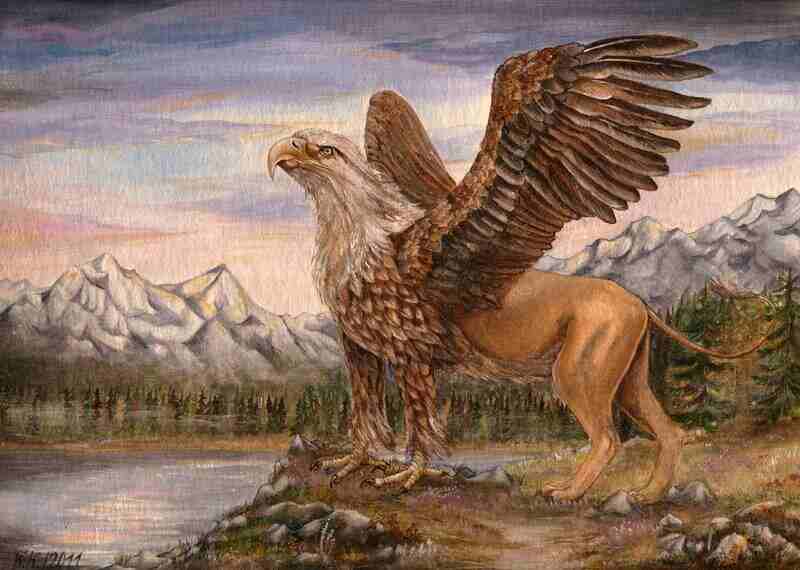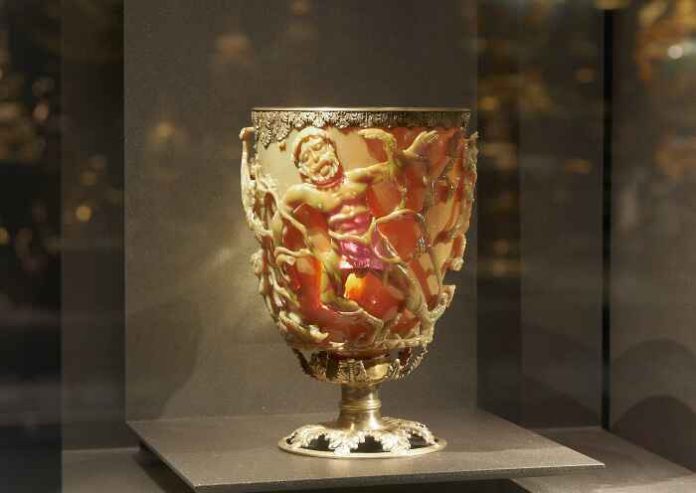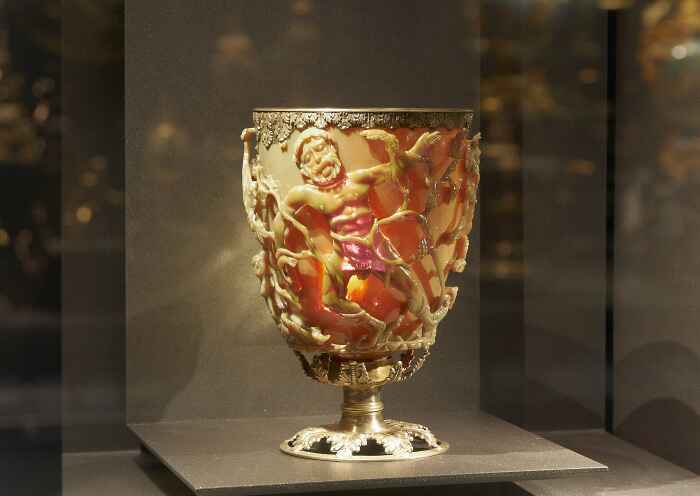The griffin, a mythical creature with the body of a lion and the head and wings of an eagle, has captured human imagination for centuries. Its origin in Greek mythology intertwines with tales of power, protection, and divine intervention. This article delves into the griffin’s place in Greek mythology, exploring its symbolism, creation, and lasting legacy.
The Origin of the Griffin in Greek Mythology
The story of the griffin begins in the ancient world, a time when myths and legends were woven into the very fabric of everyday life. The griffin, known for its unique combination of lion and eagle features, first appears in Greek mythology as a guardian of treasures and a symbol of divine power. But where did this fascinating creature originate, and how did it become such an integral part of Greek lore?
The earliest mentions of the griffin date back to around the 7th century BCE. Ancient Greek poets and historians, such as Aristeas and Herodotus, wrote about the griffin guarding vast hoards of gold in the mountains of Scythia, a region to the north of Greece. These accounts describe the griffin as a fierce protector, warding off any who dared to steal the precious metal. It was said that the griffin’s keen eyesight and powerful claws made it an unbeatable sentinel.
As these stories spread, the griffin’s image began to appear in Greek art and artifacts. Pottery from the Archaic period, roughly the 8th to 6th centuries BCE, features the griffin in various forms. Often depicted with the body of a lion, the head and wings of an eagle, and sometimes with serpent-like features, the griffin symbolized strength, courage, and protection. This powerful imagery resonated with the Greeks, who saw the griffin as a divine creature capable of safeguarding both mortal and immortal realms.
The griffin’s role in Greek mythology evolved over time. Initially, it was associated with the god Apollo, particularly in his aspect as the god of the sun and prophecy. Apollo, often depicted with attributes linked to both the sun and the heavens, found a fitting companion in the griffin, whose ability to soar through the skies and dominate the land mirrored the god’s own dominion. This connection elevated the griffin from a mere guardian to a creature of divine significance.
By the Classical period, around the 5th century BCE, the griffin had cemented its place in Greek mythology and culture. Its image adorned temples and sanctuaries, symbolizing the protection of sacred spaces. In literature, the griffin featured prominently in epic tales and poetry, further embedding its legacy in the cultural consciousness of ancient Greece.
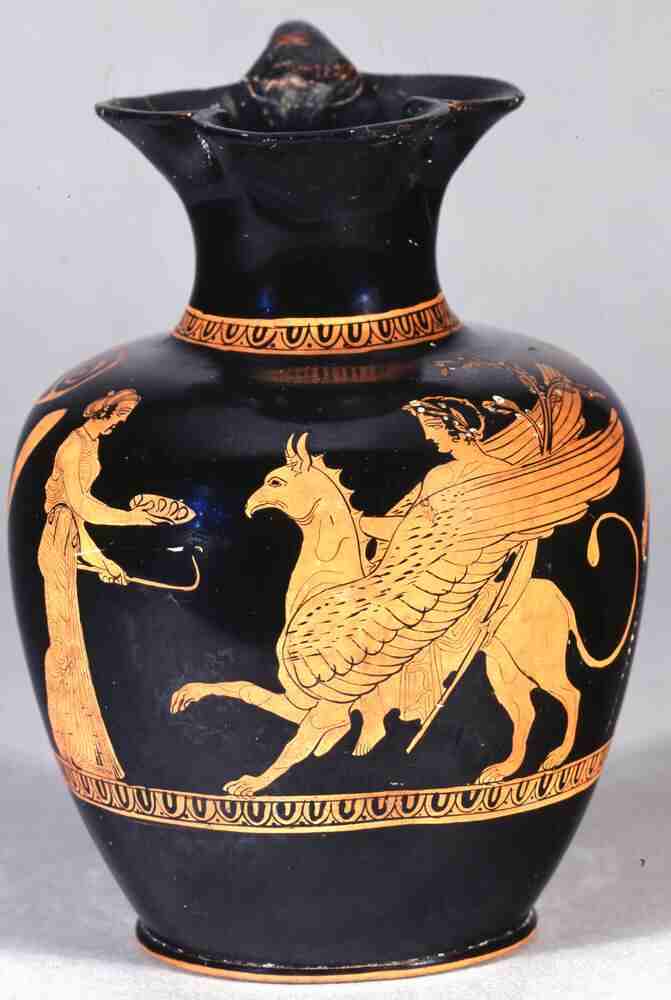
The griffin’s journey from a guardian of gold to a symbol of divine power reflects the broader narrative of Greek mythology, where creatures and deities often evolve, taking on new meanings and roles. This adaptability ensured that the griffin remained a relevant and revered figure throughout the centuries. As we continue to explore the myth of the griffin, we uncover not just a creature of legend, but a symbol deeply intertwined with the values and beliefs of ancient Greek society.
Symbolism and Significance
The griffin’s presence in Greek mythology is not merely ornamental. Its symbolic power extends deeply into the fabric of ancient Greek culture, touching on themes of divinity, protection, and harmony. To understand why the griffin was so revered, we must look at its symbolism and significance across various contexts and periods in Greek history.
Initially, the griffin’s dual nature, combining the majestic eagle and the powerful lion, represented a harmonious balance of strength and wisdom. In a world where both traits were highly valued, the griffin was seen as an ideal embodiment of these virtues. The lion, the king of beasts, symbolized bravery, ferocity, and dominance. The eagle, the king of birds, symbolized vision, swiftness, and the divine connection to the gods. Together, these attributes created a creature that was more than the sum of its parts, a perfect guardian and a powerful protector.
The griffin’s association with the god Apollo further elevated its status. Apollo, as the god of prophecy, music, and the sun, was a deity of immense importance. The griffin, often depicted beside Apollo, became a symbol of divine guardianship and enlightenment. This connection suggested that the griffin could traverse the mortal and divine realms, offering protection and wisdom from the gods themselves. Temples dedicated to Apollo and other deities frequently featured griffin statues, underscoring their protective role.
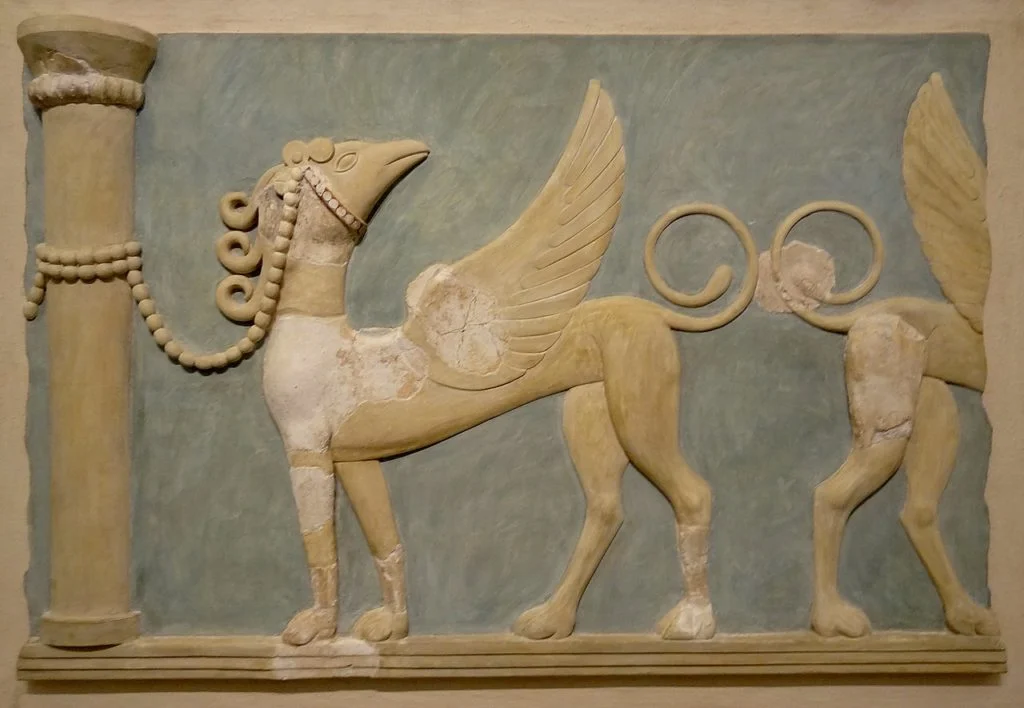
Moreover, the griffin’s imagery was pervasive in Greek art and architecture. From the 5th century BCE onwards, the griffin appeared on numerous artifacts, including pottery, coins, and sculptures. These depictions were not just artistic expressions but carried significant meaning. For instance, griffins were often placed on the corners of roofs of sacred buildings, believed to ward off evil spirits and protect the sanctity of the space. This practice was rooted in the belief that the griffin’s vigilance and strength could shield the sacred from the profane.
The symbolism of the griffin also extended to the afterlife. In some burial sites, griffin motifs were found on sarcophagi and grave goods. This association suggested that the griffin served as a protector in the journey to the afterlife, ensuring safe passage for the soul and guarding against malevolent forces. The integration of the griffin into funerary practices highlighted its role as a guardian across all realms of existence.
Interestingly, the griffin also found its way into Greek literature, where it was portrayed as both a fearsome guardian and a noble creature. In myths and epic tales, the griffin was sometimes a formidable adversary that heroes had to overcome, embodying the ultimate challenge of courage and strength. At other times, it was a loyal companion to gods and heroes, reflecting its dual nature as both a protector and a formidable force.
This multifaceted symbolism made the griffin a powerful and enduring figure in Greek mythology. Its ability to encapsulate various attributes – strength, wisdom, protection, and divinity – ensured that it remained a prominent and revered symbol throughout ancient Greek history. The griffin’s significance went beyond its mythical origins, embedding itself into the cultural and spiritual consciousness of the people, making it a timeless emblem of power and protection.
The Creation Myth
The griffin’s origins in Greek mythology are as enigmatic as the creature itself. Unlike many mythical beings with well-documented genealogies, the griffin’s creation is a blend of Greek imagination and influences from neighboring cultures. To understand how the griffin came to be, we must piece together fragments from various ancient texts, archaeological findings, and cross-cultural exchanges.
The griffin’s earliest depictions are found in the art and literature of ancient Greece, dating back to the 7th century BCE. However, scholars believe that the concept of the griffin may have been influenced by earlier civilizations. Some theories suggest that the griffin’s image was inspired by the ancient Scythians, a nomadic people from Central Asia. The Scythians were known for their intricate goldwork, which often featured mythical creatures combining animal traits. It is plausible that Greek traders and travelers encountered these depictions and adapted the griffin into their own mythology.
Another potential influence comes from ancient Egypt, where creatures with combined animal features were common in their pantheon. The Egyptian god Horus, often depicted as a falcon-headed man, and the lion-bodied sphinx, may have contributed to the griffin’s development. The blending of these influences resulted in a creature that embodied the most formidable attributes of both the eagle and the lion.
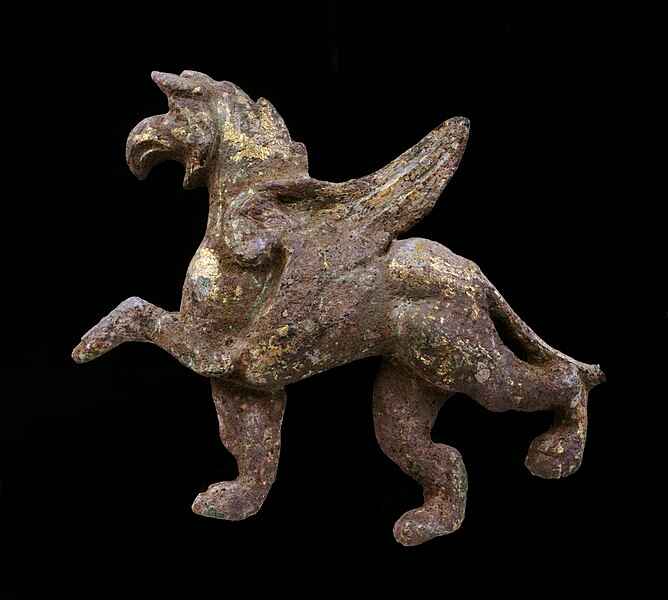
In Greek mythology, the creation of the griffin is not tied to a specific god or event. Instead, the griffin seems to emerge organically within the mythological framework, serving various symbolic roles. Early Greek writers, such as Herodotus, describe the griffin as a guardian of treasures, particularly gold, in the northern regions of Scythia. This narrative likely reflects the Greeks’ encounters with the Scythian culture and their stories of fierce creatures protecting valuable resources.
As Greek mythology evolved, so did the griffin’s role and significance. By the time of the Classical period, the griffin had become firmly entrenched in Greek culture. Its image was used extensively in art, often seen in sculptures, pottery, and architectural decorations. These depictions were not mere artistic flourishes but carried deep symbolic meaning, representing the griffin’s role as a protector and divine guardian.
The creation myth of the griffin is further complicated by its lack of a clear origin story. Unlike the detailed genealogies of gods and heroes, the griffin’s existence is more abstract, woven into the broader tapestry of Greek mythology. This ambiguity adds to the griffin’s mystique, allowing it to be adapted and reinterpreted across different contexts and periods.
In literature, the griffin’s creation is often hinted at rather than explicitly described. For example, in Aeschylus’s play “Prometheus Bound,” the griffins are mentioned as guarding the gold mines of the north, reinforcing their role as protectors of wealth and power. This portrayal aligns with the broader theme of the griffin as a guardian, both in the mortal world and in the divine realm.
The absence of a singular creation myth for the griffin allows it to embody a wide range of symbolic meanings. It can be a fierce guardian of treasures, a divine protector, or a noble companion to the gods. This flexibility ensures that the griffin remains a dynamic and enduring figure in Greek mythology, capable of adapting to various narratives and cultural shifts.
By integrating elements from different cultures and adapting to evolving mythological contexts, the griffin’s creation reflects the fluid and interconnected nature of ancient mythmaking. Its presence in Greek mythology is a testament to the Greeks’ ability to absorb and transform influences from their interactions with other civilizations, creating a creature that is uniquely their own while also universal in its appeal.
Depictions in Art and Literature
The griffin’s captivating presence in Greek mythology is vividly illustrated through its extensive depictions in art and literature. From the earliest times, the griffin has been a favored subject, capturing the imagination of artists and writers alike. Its image not only graced numerous artifacts but also permeated the literary works of ancient Greece, embedding itself deeply into the cultural and artistic landscape.
In the world of ancient Greek art, the griffin began to appear prominently during the Archaic period, around the 8th to 6th centuries BCE. One of the earliest and most striking representations of the griffin is found on pottery. Vase paintings from this period frequently depict the griffin with the body of a lion and the head and wings of an eagle, embodying the dual nature that made it such a powerful symbol. These vases, often used in religious and domestic contexts, highlight the griffin’s role as both a protector and a divine creature.
Moving into the Classical period, around the 5th century BCE, the griffin’s image became even more widespread and elaborate. Sculptors and metalworkers began to create more detailed and lifelike representations. One notable example is the bronze griffin protome, an attachment often found on cauldrons and other ceremonial objects. These bronze works, with their intricate detailing, showcase the craftsmanship and the reverence the Greeks had for the griffin.
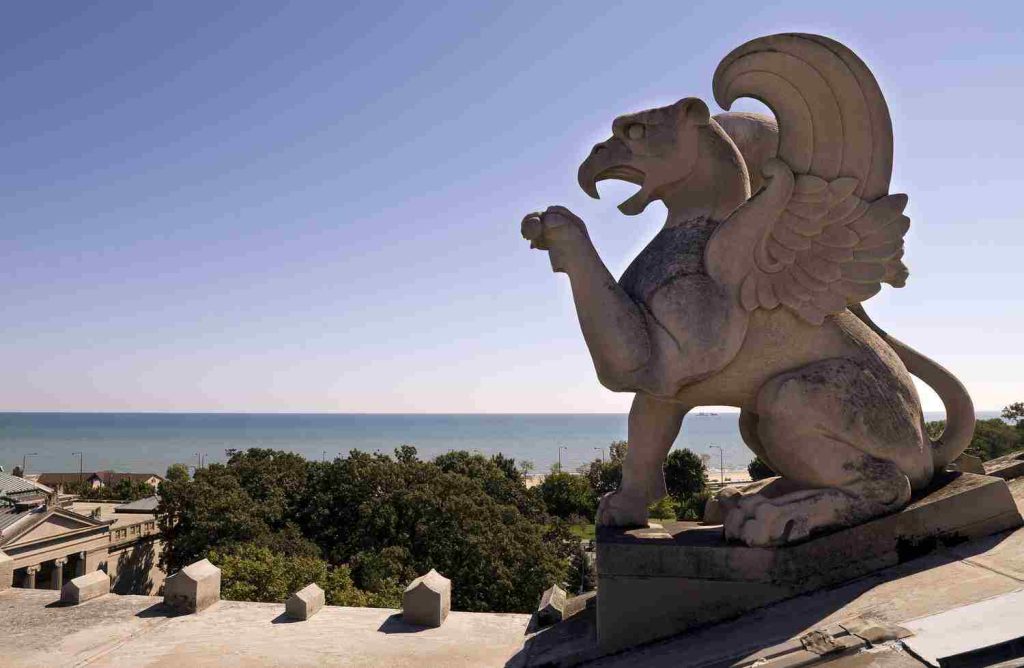
Architectural elements also featured the griffin prominently. Temples and public buildings often incorporated griffin motifs, particularly in friezes and pediments. The griffin was believed to protect sacred spaces, and its image served as a reminder of divine guardianship. These architectural depictions were not just decorative; they carried significant symbolic weight, reinforcing the griffin’s role in protecting the divine and the mortal realms.
In literature, the griffin’s presence is equally significant. The earliest literary mentions of the griffin can be traced back to the works of ancient Greek poets and historians. Herodotus, often referred to as the “Father of History,” wrote about the griffins guarding gold in the northern lands of Scythia. This description not only highlights the griffin’s role as a guardian but also its connection to wealth and power.
For readers interested in exploring other fascinating creatures from ancient Greek mythology, the Sphinx from Greek Mythology offers another compelling story of a guardian with a unique blend of animal traits. This mythical creature, known for its enigmatic riddles, further enriches the tapestry of Greek myths and legends.
The griffin’s literary journey continued through the works of Aeschylus and other playwrights. In “Prometheus Bound,” Aeschylus refers to the griffins in the context of their vigilance and strength. These references served to embed the griffin further into the cultural consciousness, making it a familiar and revered figure in the Greek mythological canon.
The Hellenistic period saw a continuation and expansion of griffin imagery and references. As Greek culture spread through the conquests of Alexander the Great, the griffin’s image was carried far and wide, influencing and being influenced by other cultures. This period saw an increase in the fusion of Greek and Eastern artistic styles, resulting in even more diverse and elaborate depictions of the griffin.
Interestingly, the griffin’s influence extended beyond the realms of myth and art into more practical applications. Coins from various Greek city-states often featured the griffin, symbolizing strength and protection. This practice not only underscored the griffin’s symbolic power but also its role in everyday Greek life, serving as a reminder of divine presence and protection in mundane transactions.
The griffin’s journey through art and literature reveals a creature that was not static but evolved with Greek culture. Its enduring presence in these mediums reflects its deep-seated significance, serving as both a guardian and a symbol of divine power. Through the ages, the griffin has remained a potent emblem of the virtues and values that were central to ancient Greek society, immortalized in their artistic and literary heritage.
Frequently Asked Questions (FAQs)
1. What is a griffin in Greek mythology?
A griffin in Greek mythology is a mythical creature with the body of a lion and the head and wings of an eagle. It symbolizes strength, protection, and divine power.
2. What does the griffin symbolize in Greek mythology?
The griffin symbolizes a harmonious balance of strength and wisdom. It is a guardian of treasures, a protector of sacred spaces, and a symbol of divine guardianship and enlightenment.
3. How was the griffin created in Greek mythology?
The griffin’s creation in Greek mythology is not tied to a specific god or event. It is believed to have emerged from a blend of Greek imagination and influences from neighboring cultures such as the Scythians and Egyptians.
4. What does griffin mean in Greek?
In Greek, the word “griffin” (or “gryphon”) does not have a direct translation. It is derived from the ancient Greek word “gryps,” which describes the mythical creature.
5. How is the griffin depicted in Greek art and literature?
In Greek art and literature, the griffin is depicted with the body of a lion and the head and wings of an eagle. It appears in various forms, including pottery, sculptures, and literary works, symbolizing protection and divine power.
The Griffin’s Legacy in Modern Culture
The griffin’s enduring legacy transcends ancient Greek mythology, finding new life and relevance in modern culture. This mythical creature, with its amalgamation of eagle and lion features, continues to captivate the imagination of people around the world. Its journey from ancient myth to contemporary icon is a testament to its powerful symbolism and universal appeal.
In the medieval period, the griffin maintained its significance, appearing in heraldry and coats of arms across Europe. Nobles and knights adopted the griffin as a symbol of bravery, vigilance, and strength. This period saw the griffin’s image evolving, often depicted with more elaborate and fierce features to represent the martial prowess and noble lineage of its bearers. The griffin’s role as a guardian was highlighted in these contexts, protecting not just treasures but also the honor and legacy of noble families.
Moving into the Renaissance, the griffin’s imagery was revived in art and literature, echoing its classical roots while integrating contemporary aesthetics. Artists like Albrecht Dürer and Leonardo da Vinci included griffins in their works, showcasing the creature’s dynamic form and symbolic depth. The Renaissance fascination with classical antiquity brought the griffin back into the cultural spotlight, where it symbolized the intellectual and artistic rebirth of the period.
In modern times, the griffin continues to inspire a wide array of cultural expressions. Literature, film, and video games often feature griffins as central characters or powerful symbols. For instance, J.K. Rowling’s “Harry Potter” series includes the griffin in various forms, connecting contemporary audiences with ancient mythological themes. Similarly, the griffin appears in video games like “Assassin’s Creed” and “World of Warcraft,” where it serves as both a formidable adversary and a loyal companion.
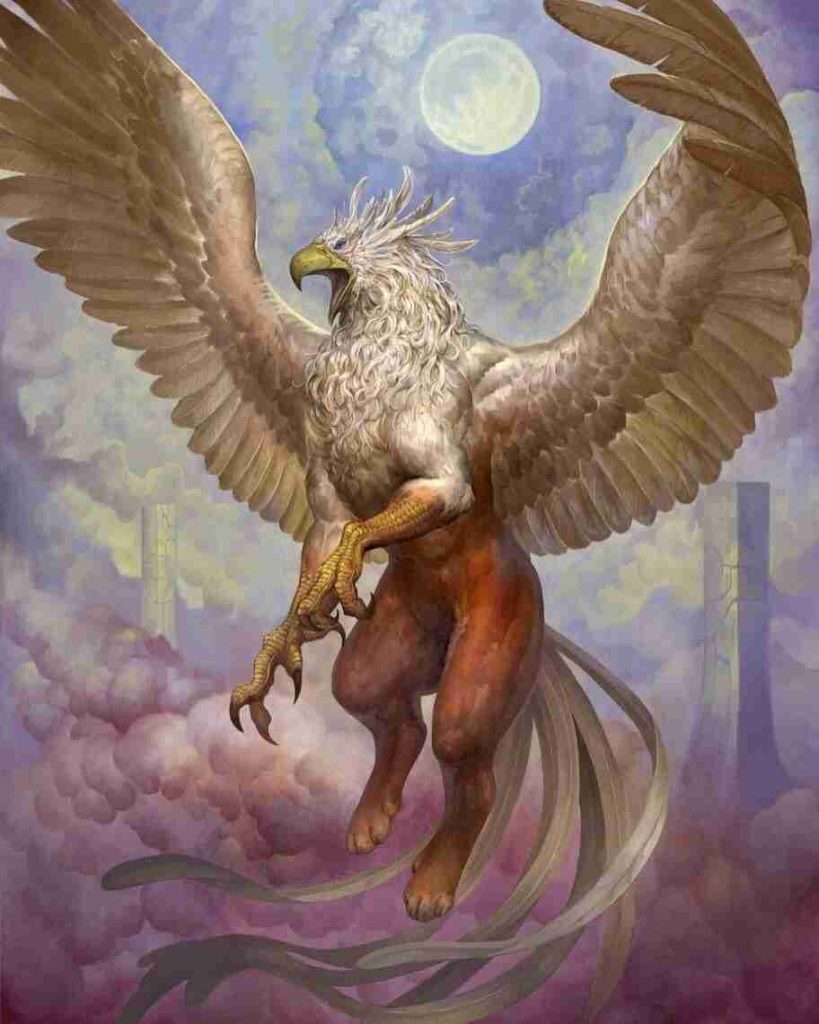
The griffin’s presence in popular culture extends to the realm of tattoos and personal adornment. Many people choose griffin tattoos to symbolize protection, courage, and wisdom. The intricate designs often incorporate elements of both the eagle and the lion, reflecting the creature’s dual nature. This modern form of expression highlights the griffin’s lasting impact and its ability to convey powerful messages across different contexts.
Additionally, the griffin has found a place in modern architecture and branding. Universities, corporations, and sports teams adopt the griffin as a mascot or emblem, leveraging its association with strength, protection, and excellence. The University of Guelph in Canada, for example, uses the griffin as its mascot, symbolizing the institution’s commitment to vigilance and academic rigor.
The griffin’s adaptability and timeless appeal are also evident in its influence on modern fantasy and speculative fiction. Authors and creators draw upon the rich tapestry of griffin mythology to craft new stories and worlds. In these narratives, the griffin often embodies themes of guardianship, loyalty, and the intersection of the natural and supernatural realms. This creative reimagining ensures that the griffin remains a vibrant and relevant figure in contemporary storytelling.
Moreover, the griffin’s legacy is preserved through museums and historical exhibitions. Artifacts from ancient Greece and beyond, featuring griffin motifs, are displayed in institutions like the British Museum and the Louvre. These exhibits educate the public about the griffin’s historical significance and its evolution over the centuries. By showcasing these pieces, museums help keep the myth of the griffin alive, bridging the gap between past and present.
In essence, the griffin’s journey from ancient myth to modern icon reflects its enduring power and versatility. Its ability to adapt and remain relevant across different eras and cultures speaks to the universal qualities it embodies. As we continue to explore and reinterpret the myth of the griffin, we find that this majestic creature still has much to offer in terms of symbolism, inspiration, and cultural significance.
Use of Our Content
⚠️ Content on “Mystery Uncover” is protected under US and International Copyright Laws.
You are free to reuse, republish, and share our content by giving credit to the source as Mystery Uncover with a link to the original material on mysteryuncover.com.


